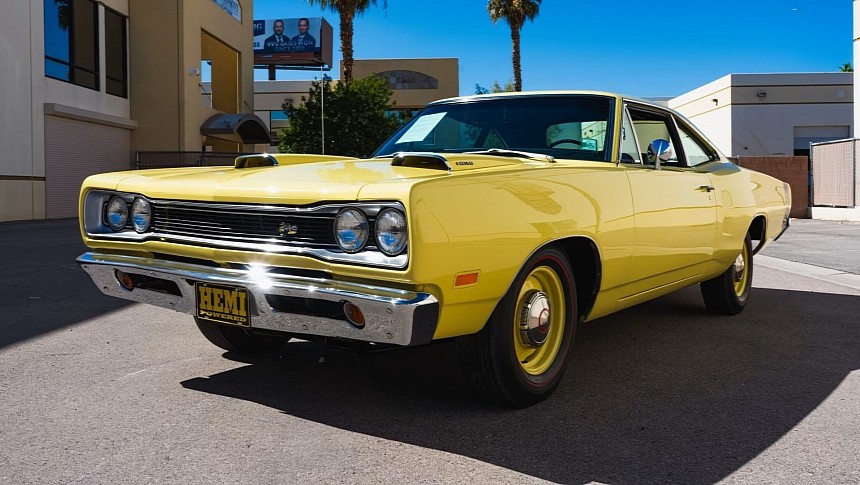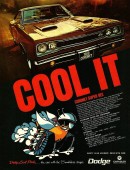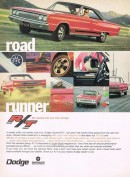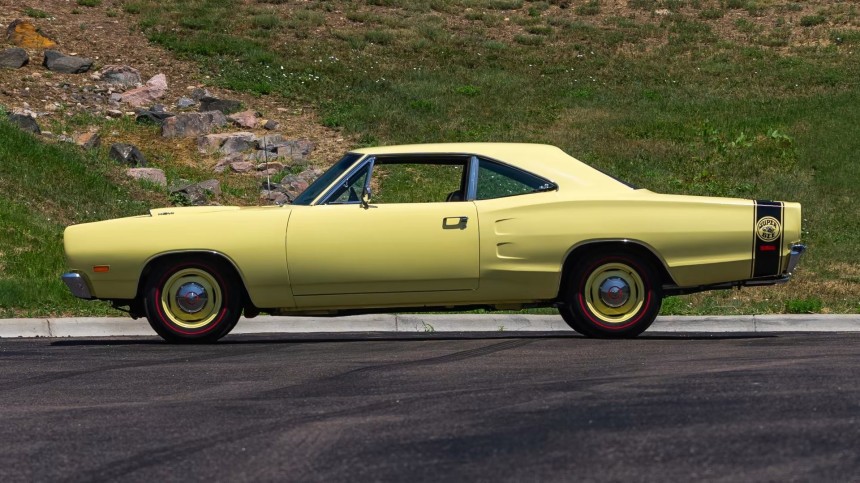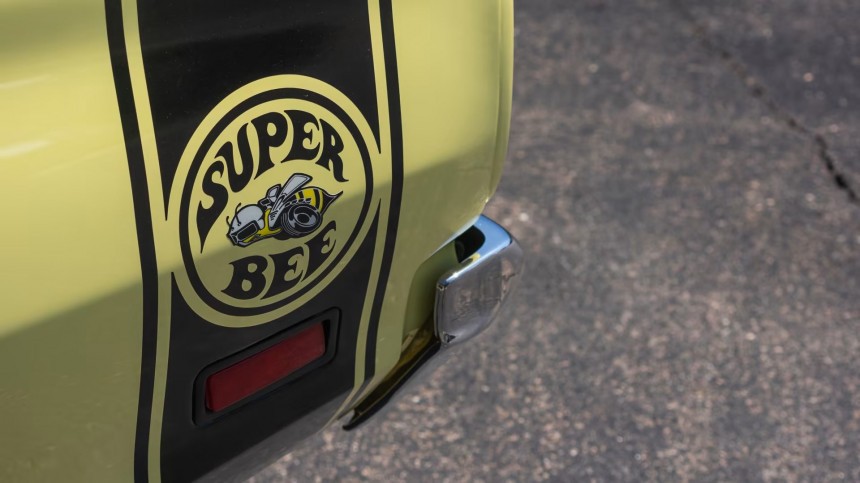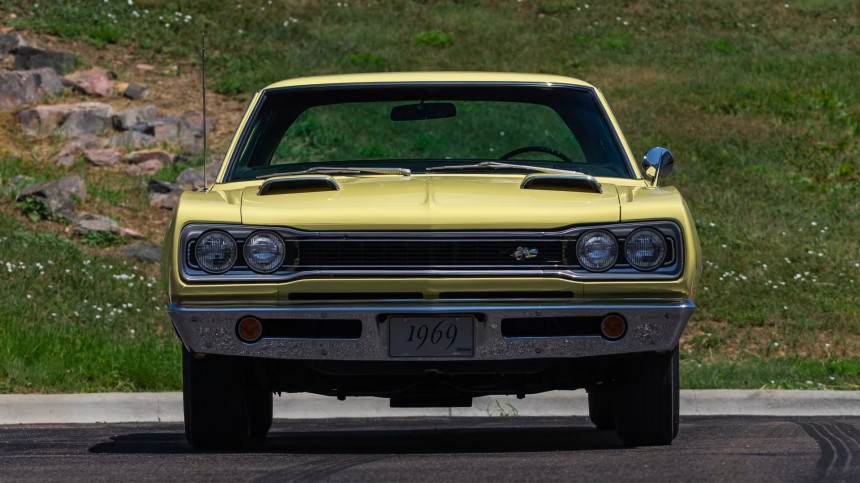When Dodge introduced the ‘road runner’ in 1967 to mark the launch of its Road/Track performance sub-model, they used the Coronet as the catapult for the go-fast offer. Before you give the ‘Fire at will!’ direct order to the firing squadron lined up in front of me, read on and learn how the Chrysler division played dodgeball (pun intended) with the other Mopar high-performance aspirant, Plymouth, and how one Dodge grew honey-making HEMI wings.
Let’s settle the quarrel about the opening line of this article’s introduction: the Road Runner is a Plymouth model; there is no debate here. Launched in the fall of 1967 as a 1968 model, the car was a low-cost, low-option Mopar with a lot of punching power. And the recipe worked sales-wise – people bought it for what it was.
But in the same year (1967), the rival siblings from Dodge came with an equally performant offer (albeit not in the same price range): the R/T optional package for the Coronet. One of the advertisements for the newly introduced model (see it in the gallery) had the words ‘road runner’ (written in all lowercase).
However, by mid-year 1968, the bean counters at Dodge realized that the cheapo Plymouth was beating the Dodge hard in the corporate game of “Show Me the Money.” Carmakers are in their business to make the wherewithal, not have their names engraved in the eternal pantheon of tire-sublimating glory. So, Dodge took note of what was happening in the next room and came up with their own version of a go-fast, pay-low automobile.
Since the Road Runner was shamelessly and simultaneously above and below the Coronet (high in sales, low in base price), Dodge brass decided it was time for a payback after Plymouth had ingeniously secured the Warner Bros name for its personal and exclusive use. Since both the Coronet and the Road Runner belonged to the B-body platform, Dodge played a clever portmanteau and released a Super Bee (Super-B) variant of the Coronet.
Just like the Road Runner, it came with a supered-up 383 cubic-inch (6.3-liter) engine, and just like the first-year Plymouth RR, it offered the alternative powerplant in its absolute form: the road-shredding 426 HEMI. The copycat tactics extended to the body styles: 1968 Plymouth RR – post coupe; 1968 Dodge Coronet Super Bee – post coupe.
In 1969, Dodge introduced the hardtop and the 440-6 engine, and this double punch hit sales figures with an uppercut that propelled production numbers to over three-fold those of the previous year, at 26,563. (We should remember that in 1968, the Super Bee arrived mid-season, hence the 7,841 domestic-market-sold examples).
The fresh-for-the-year pillarless hardtop got the lion’s share – with buyers rushing in like a bee to honey (pun unavoidable): 18,361 Super Bees came with the hollowed-out cabin perimeter, compared to the 8,202 classic, Grandpa Joe’s slant-six lookalike coupes. In a natural progression, accurately reflecting the ascending price curb, the 383 V8 was the workhorse of the sales effort for 1969. It was followed – at a great distance – by the biggest performance V8 available in the muscle car society of 1969, the mighty 440-CID (7.2-liter) Six-Pack Magnum. Lower still was the 426-cubic-fun HEMI: 256 units were built in total – 165 leaving the assembly plant as hardtops.
The HEMI coupe is the rarest of the pack, with 91 automobiles equipped with the powerfully expensive motor: 53 with the optional bullet-proof TorqueFlite automatic and 38 with the standard four-speed manual. The mathematical conclusion is that the three-pedal, four-on-the-floor Super Bee is the one to look for if Mopar is the answer to all wrench-turning questions.
There is one available, should anyone be interested, and it’s been in hot demand in the last five years, being sold two times between 2018 and 2022. And it’s up for grabs one more time, for no small reason: matching numbers engine and transmission with the Super Track Pack option.
Even though it started small, at a $3,183 base price, the HEMI added $848 – nearly a quarter of the price, putting it right alongside the Charger. However, buying the 426 Elephant meant not just a big-block tremor with enormous power but a whole different car altogether.
Stiffer suspension, sturdier leaf springs on the rear, power brakes, factory torque boxes (usually put on convertible cars, but the Coronet Super Bee had a sheet of metal over the cabin), and dual Ramcharger Air Induction hood scoops – all came together with the emblematic motor. One brochure from 1969 described the dual air-grabbing ducts like this: “The vent opens, and a sudden rush of cool, dense air is rammed through the carburetor. The engine gets the message loud and strong. You might say the Ramcharger turns a hot mill on by cooling it.”
The car we see here will go under the hammer in November in Las Vegas and has already been sold twice – the last time in the summer of 2022 (also in the capital city of Nevada, for $165,000). The car has been restored to blueprint quality not once but twice, and the engine has been fully rebuilt.
In 2018, after its second refurbishment (a three-year project), the odometer recorded 65,237 miles (104,966 km). The clock now shows 65,461 (105,327 km), and the selling dealer asks $219,850 for it. However, it will go under the hammer at the Mecum auction on November 9-11; we’ll see if a new buyer is willing to cough up the money.
But in the same year (1967), the rival siblings from Dodge came with an equally performant offer (albeit not in the same price range): the R/T optional package for the Coronet. One of the advertisements for the newly introduced model (see it in the gallery) had the words ‘road runner’ (written in all lowercase).
However, by mid-year 1968, the bean counters at Dodge realized that the cheapo Plymouth was beating the Dodge hard in the corporate game of “Show Me the Money.” Carmakers are in their business to make the wherewithal, not have their names engraved in the eternal pantheon of tire-sublimating glory. So, Dodge took note of what was happening in the next room and came up with their own version of a go-fast, pay-low automobile.
Just like the Road Runner, it came with a supered-up 383 cubic-inch (6.3-liter) engine, and just like the first-year Plymouth RR, it offered the alternative powerplant in its absolute form: the road-shredding 426 HEMI. The copycat tactics extended to the body styles: 1968 Plymouth RR – post coupe; 1968 Dodge Coronet Super Bee – post coupe.
In 1969, Dodge introduced the hardtop and the 440-6 engine, and this double punch hit sales figures with an uppercut that propelled production numbers to over three-fold those of the previous year, at 26,563. (We should remember that in 1968, the Super Bee arrived mid-season, hence the 7,841 domestic-market-sold examples).
The HEMI coupe is the rarest of the pack, with 91 automobiles equipped with the powerfully expensive motor: 53 with the optional bullet-proof TorqueFlite automatic and 38 with the standard four-speed manual. The mathematical conclusion is that the three-pedal, four-on-the-floor Super Bee is the one to look for if Mopar is the answer to all wrench-turning questions.
There is one available, should anyone be interested, and it’s been in hot demand in the last five years, being sold two times between 2018 and 2022. And it’s up for grabs one more time, for no small reason: matching numbers engine and transmission with the Super Track Pack option.
Stiffer suspension, sturdier leaf springs on the rear, power brakes, factory torque boxes (usually put on convertible cars, but the Coronet Super Bee had a sheet of metal over the cabin), and dual Ramcharger Air Induction hood scoops – all came together with the emblematic motor. One brochure from 1969 described the dual air-grabbing ducts like this: “The vent opens, and a sudden rush of cool, dense air is rammed through the carburetor. The engine gets the message loud and strong. You might say the Ramcharger turns a hot mill on by cooling it.”
The car we see here will go under the hammer in November in Las Vegas and has already been sold twice – the last time in the summer of 2022 (also in the capital city of Nevada, for $165,000). The car has been restored to blueprint quality not once but twice, and the engine has been fully rebuilt.
In 2018, after its second refurbishment (a three-year project), the odometer recorded 65,237 miles (104,966 km). The clock now shows 65,461 (105,327 km), and the selling dealer asks $219,850 for it. However, it will go under the hammer at the Mecum auction on November 9-11; we’ll see if a new buyer is willing to cough up the money.
